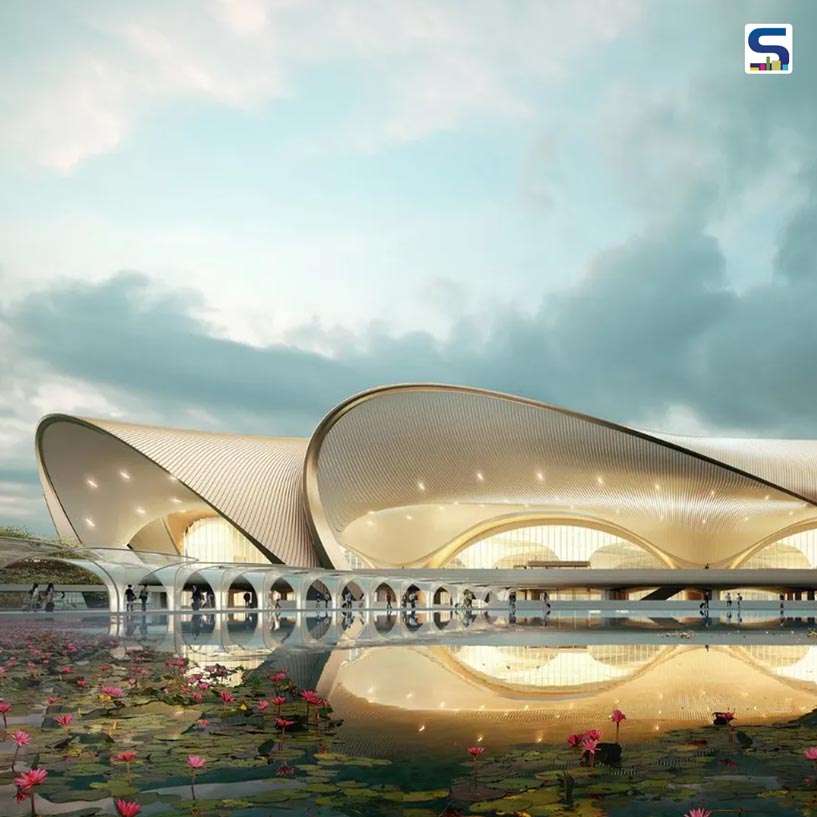
The Navi Mumbai International Airport (NMIA) terminal, designed by Zaha Hadid Architects (ZHA), stands as a monumental step in India’s infrastructure evolution with its unique design and cutting-edge engineering. Celebrated as a futuristic landmark, the project reflects the firm’s unique style of fluid geometry and advanced digital design, while also responding thoughtfully to the climatic, cultural and operational challenges of the surrounding. Envisioned as a new gateway to India’s financial capital, SURFACES REPORTER (SR) tells how such a terminal can redefine contemporary airport architecture with innovation and creativity.
Lotus-inspired airport terminal
Awarded after an international design competition in 2018, NMIA is Zaha Hadid Architects’ most significant Indian commission to date and one of its largest airport projects globally. The firm’s scope encompasses Terminal 1, the air traffic control tower and key landside infrastructure. Rather than using the lotus, a powerful symbol in Indian art and spirituality, as a decorative motif, ZHA reinterpreted it as the terminal’s generative geometry. The roof unfolds like a lotus in bloom, with petal-like canopies that define the building’s form, light and flow. Each petal is designed to address functional needs such as daylighting, ventilation, wind pressure and monsoon drainage. The central atrium acts as a symbolic pond, anchoring the concourses that radiate outward. The result of this is a terminal that not only performs efficiently but also embodies India’s spiritual and architectural essence in contemporary form.
The translation of the lotus’s organic form into a constructible structure required extraordinary precision and collaboration between architects, engineers and fabricators. Each roof segment had been digitally rationalized through parametric modeling and prefabricated in modular steel units, allowing seamless assembly on site. Laser-guided alignment and custom molds ensured that every petal aligned perfectly across vast spans. The hybrid structure combines reinforced concrete cores with a steel superframe and tensile cladding designed to withstand seismic activity, high wind loads, and monsoon conditions.
Redefining Mumbai’s airway
Inside, NMIA’s spatial flow is defined by a dual-column system that balances expression with structural necessity. 12 sculptural feature columns, hollowed and flared to resemble unfolding petals, serve as luminous beacons within the terminal. They channel natural light into the passenger halls, acting as visual anchors that orient travelers. Behind them, 17 mega-columns shoulder the building’s structural loads, supporting the 370m long roof and resisting environmental stresses typical of Mumbai’s coastal region. This clear separation of expressive and functional systems lends the terminal an illusion of weightlessness while preserving technical precision.
ZHA’s design also draws deeply from Indian architectural traditions. The columned halls recall the grandeur of temple mandapas, while the interplay of filtered light and axial procession evokes the spatial choreography of ancient civic and sacred spaces. Thus, the building becomes both a functional hub and a cultural metaphor.
Light plays a central role in shaping this experience. Continuous skylight strips embedded in the roof petals are optimized through solar-angle modeling to maximize daylight while minimizing glare and heat gain. The hollow feature columns act as vertical shafts, drawing sunlight deep into the concourse and reducing energy dependence during daytime operations. This subtle choreography of light transforms the act of transit into an experiential journey, where movement, shadow and time interact fluidly.
The airport’s modular master plan underscores scalability and adaptability, which is a key for a rapidly expanding metropolis like Mumbai. Phase 1, now complete, can reportedly accommodate around 20 million passengers annually, with future expansions planned to increase capacity up to 90 million. Spanning approximately 1,160 hectares between Panvel Creek and the Ulwe River, the site is organized for seamless integration of subsequent terminals and a second parallel runway.
Project details
Project name: Navi Mumbai International Airport (NMIA)
Location: Navi Mumbai, Maharashtra
Status: 2018-TBC
Studio: Zaha Hadid Architects
Project directors: Cristiano Ceccato and Filippo Innocenti
Project designer: Paulo Flores
Project architects: Clara Martins, Lydia Kim and Shao-Wei Huang (competition stage)
Project lead (architectural design): Karoly Markos
Project lead (terminal infrastructure design): Leo Alves
Project lead (CTC, Landside and airside master plan): Ashwin Shah
Project team: Ariss Majid, Clara Martins, Dominic Vadra-Edwards, Eckart Schwerdtfeger, Fernando Alvarenga, Harry Ibbs, Jakub Klaska, Li Jin, Maria Avrami, Maria Touloupou, Maria Tsironi, Mariana Custodio Dos Santos, Mark Winnington, Mauro Sabiu, Michail Desyllas, Paul Bart, Sai Prateik Bhasgi, Saman Dadgostar, Seungho Yeo, Sharan Sundar, Takehiko Iseki and Zohra Rougab
Photographs: Zaha Hadid Architects